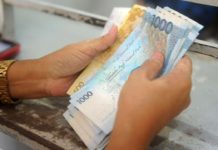
MOST Asian currencies were little changed on Friday as investors weighed the political situation in the United States (US) and waited for developments on the US-China trade war front.
A whistle-blower report released on Thursday said US President Donald Trump not only attempted to solicit Ukraine’s interference in the 2020 US election for his political benefit, but that the White House tried to “lock down” evidence about that conduct.
Investors
are also looking for hints of progress in Sino-US trade relations ahead of
talks next month to see if the two economies could clinch a deal to end the protracted
trade war.
China’s top diplomat said China was willing to buy more US products, and said
trade talks would yield results if both sides “take more enthusiastic measures”
to show goodwill and reduce “pessimistic language” in their tariff dispute.
Sim Moh Siong, a FX strategist at Bank of Singapore, said he sees a holding pattern for emerging Asian currencies, amid competing factors of trade developments and US political issues.
“Investors are not sure what the dominant issue next week will be,” he added.
The Philippine peso leapt 0.5 percent, making it the top gainer in the region. The central bank cut interest rates for a third time as expected on Thursday, and indicated that future cuts would be data-dependent.
The South Korean won edged lower. South Korean exports are seen contracting for the 10th consecutive month in September, although at a slower pace, according to a poll. The data is expected on Tuesday.
The prolonged Sino-US trade war and uncertainty about a recovery in the semiconductor industry continue to weigh on the South Korean economy.
The Indonesian rupiah was steady. Officials on Thursday said the government might allow its 2019 fiscal deficit to widen further than 1.93 percent of gross domestic product to maintain growth momentum.
TO EXCLUDE OR NOT TO EXCLUDE? – STATUS OF MALAYSIAN BONDS
The Malaysian ringgit strengthened 0.2 percent after index provider FTSE Russell retained Malaysian government bonds on its World Government Bond Index.
The FTSE gave the country six months to try and improve liquidity to avoid eviction from the index, and said it will provide another update after an interim review in March.
However, analysts said with Malaysia’s status under review, its exclusion from the index has been priced in, limiting the impact on the currency.
“Any negative impact on the MYR (Malaysian ringgit) from index exclusion could be limited to around 1 percent to 2 percent losses. A positive affirmation of Malaysia’s market accessibility by FTSE will trigger MYR strength,” DBS said in a note.
The ringgit has declined 0.4 percent so far this week. (Reuters)







